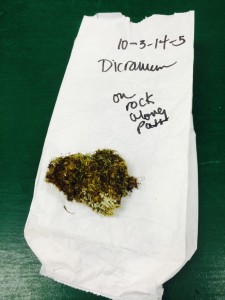When told that a herbarium is a collection of plants, most people think of flowering plants or pine trees, or perhaps even ferns. The herbarium possesses these plants, but it also has other plants – an often, overlooked group of plants, the bryophytes that include mosses, liverworts and hornworts.

An example of a bryophyte, the ribbed bog moss, Aulacomnium palustre, with stalks of propagules that will be dispersed for asexual reproduction. From a wet meadow at Waldo, Marion County, Ohio. April 21, 2006. Photo by Bob Klips.
Bryophytes are small. As a result, the characters that distinguish bryophytes are small, microscopically so, but the array of beauty and intricacy displayed in flowering plants also are present in bryophytes. Those researchers that study bryophytes, bryologists, are privileged to observe this vibrant world of miniature plants.

An example of the complexity and elegance of the spore-producing structures of the small-mouthed thread moss, Bryum lisae var. cuspidatum, as observed by a bryologist. Alum Creek State Park, Waldo, Marion County. April 17, 2008. Photo by Bob Klips.

Bryophytes are small plants and often require the use of dissecting and compound microscopes to view diagnostic characters. Here bryologist Diane Lucas uses the compound microscope to view the shape and size of the leaf cells of a moss.

A leaf of the moss, Bryum flaccidum, showing hexagonal leaf cells. Moss and liverwort leaves are only one cell layer thick, thus each individual leaf cell is easily visible, as seen here viewed with the compound microscope. The shape and size of the leaf cells are often used to distinguish moss species.
Bryophytes often grow in places where other plants cannot grow, such as on the sides of trees or on the surface of boulders. Bryophytes are able to grow on such substrates because they are able to survive after drying to conditions equal to the water content of the surrounding environment, conditions that would cause wilting and death in other plants. Poikilohydry, this ability to dry and then re-establish growth in the presence of moisture, is a character that flowering plants have evolutionarily lost. In herbaria, the poikilohydric nature of bryophytes has been observed in some specimens that are able to grow after five, ten or twenty years dried in a herbarium.

A typical habitat of the rounded tongue moss, Anomodon minor, on limestone rock. From Duranceaux Park, Delaware County, Ohio. April 24, 2011. Photo by Bob Klips.
Bryophyte specimens are easier to collect and to preserve compared to other plants because they do not require pressing, or mounting onto herbarium sheets. While in the field, bryophyte plants are assigned a collection number and placed into small paper bags or paper envelopes, where they are dried. In the herbarium, bryophytes are stored in envelope packets that are made from 100% cotton rag archival paper. Labels with species identification, collection location, habitat information, collection date and collector are printed onto the face of the envelope. The envelopes are stored in flat boxes specially designed to fit on the shelves of herbarium cabinets.

Bryophytes are collected in the field in paper bags or envelopes. The bag in the photo has a collection number at the top, followed by a tentative field identification and the substrate on which the moss (shown on top of bag) was collected.

Typical information on face of a bryophyte packet, in this case, a packet of a moss from Crawford County, Ohio.
The Ohio State University Herbarium contains over 10,000 specimens of bryophytes – a bryologist’s delight.

From a bryologist’s point of view – delighting in the world of small plants: the moss, Fissidens subbasilaris, with stalks subtended by oblong sporangia that contain spores. From Christmas Rocks State Nature Preserve, Fairfield County, Ohio. September 7, 2014. Photo by Bob Klips.
About the Author: Dr. Cynthia Dassler is Curator of Cryptogams (small plants that produce spores) at The Ohio State Herbarium (OS) in the Department of Evolution, Ecology and Organismal Biology.




















